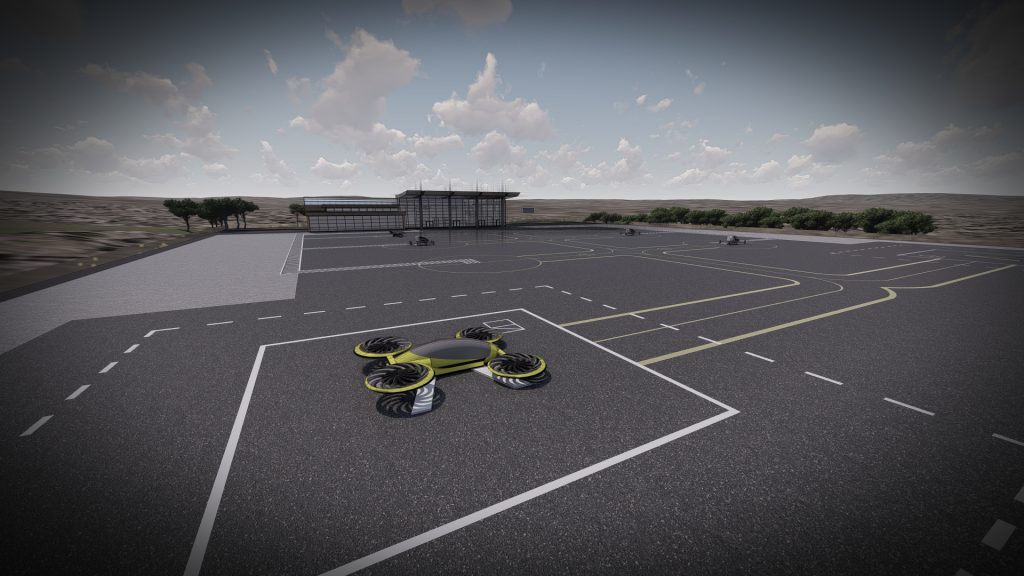New Year:
New Thoughts
Ideas from L&B collaboration with Swinburne University
Edited by: Ian Guy with Lisa Schafer and Rich Barone
Share This Story:
Table of Contents
L&B believes in engaging the next generation of thought-leaders and in understanding the needs and desires of this emerging cohort of air travellers. To this end, in the middle of 2022 our Australian team partnered with the Swinburne University Aviation Management program to assist in the delivery and implementation of a new learning module. This edition of the L&B LAB is one of the collaboration efforts of this partnership.
The first-year students at the Swinburne University Aviation and Aviation Management bachelor’s degree programs were offered a learning unit titled “Aviation Project – Blue Sky Ideas.” The purpose of the unit was to introduce students to principles of project management, collaborative teamwork, research and idea generation, as well as technical documentation. Swinburne also designed the unit to be administered with industry support as part of preparing students for future careers. To support the project, L&B and Swinburne’s academic staff provided the students with eight current emerging topics impacting the aviation industry for which they could conduct further research. These topics included:
Hydrogen powered aircraft
Electric vertical take-off and landing (eVTOL)
Global health events
Supersonic travel
Hidden disabilities
Aging of the global population
Artificial intelligence and automation
Societal trends
The LAB in 2023
“When we started the L&B LAB in 2020, we envisioned it as forum to reflect on industry needs, to conduct research, and to develop new tools to support our clients. Our plan was to release rich content based on Research & Development (R&D) pertaining to the aviation industry and to be distributed several times a year. Suddenly, our world was turned upside down when COVID-19 hit, and L&B responded with frequent articles on the impact of COVID-19 and included other related aviation topics impacting travel restrictions and lockdowns and procedures.
As we enter 2023, L&B LAB will focus more on research and discrete projects for the quarterly publications. With that in mind, our next quarterly edition will be released in May of 2023. We’d like to thank all our readers and contributors.”

Rich Barone
Chair, L&B LAB
Over the semester of study, the students formed more than 25 small delivery groups, selected their topics, and developed ideas for a “product” that could benefit the aviation industry in one of the noted eight topic areas. Students concluded the semester by presenting their proposals to Swinburne and L&B staff for review.
The following “Top Three” are ideas and presentations that we found are the best concepts presented by the students. The subsequent “Ideas of Note” are additional concepts that L&B believes would also be of interest to LAB readers.
Top 3 Ideas

Hydrogen Implementation
(Group A)
Group A proposed that a clear proposition exists at certain airports for improved sustainability with revenue generation that could also bring efficiencies to apron and land use. They proposed that a single business could establish an airport end-to-end hydrogen demand and use model. The company would buy (or make) green hydrogen local to their airport; therefore, it would use some of the hydrogen to power common-use ground servicing equipment (GSE). The students in the group identified that the strategy would enable airports and airlines to transition from carbon-based fuels in order to provide a clear market for a hydrogen plant. This transition allows testing of the use of hydrogen in quantities at airports in advance of potential hydrogen aircraft. It will also allow airports to create a more streamlined single source fleet of GSE that could potentially reduce apron parking demand. It was noted that moving to a single source of GSE equipment at an airport to be shared by all ground handlers has other implications that need to be considered.
Groups
- Ramy Zeno, Tri Duc Mguyen, Vinh Hoang
- Thomas Waldron, Olivia Moody, Hisham Tariq, Ireland Howard
- Jesse Dattar, Cecile Jin, Olivia Frizziero
- William Allen, Emily Corbitt, Donovan Lee, Alexander Carter, Charlie Dore.
- Warren Chauhan, Alex Renouf, Sam Middleton, Allan Ma, Jasper van Poppel, Goerge Sajive
- Thomas Bates, Roseanne Kimoden, Ashanti Wiley, Isaac Wilson
(This group is also commended for the quality of their written submission.) - Ruby Harris, Maddison Mo, Lara Wittey, Ella Barrell

Regional eVTOL Sites
(Group B)
Much of the discussion about eVTOL has centered around the implementation in metropolitan areas. However, Group B looked at how eVTOL has the potential to provide service to smaller more remote communities. The group identified that the aircraft capabilities are being investigated by several manufacturers; however, there is a likely market trend for small eVTOL-ports in regional areas. The group proposed that a standard product be developed for such eVTOL-ports. The product would include a “flat pack” landing/parking surface, “terminal” building, fencing and access arrangements, and meteorological equipment. Such eVTOL-ports could then be deployed to locations with full knowledge that their implementation is compliant with regulations, thus creating economies of scale for a wider roll out of this emerging technology.


Regional Airport Monitoring
(Group C)
Group C recognized an issue in the industry that L&B has experienced through our provision of Certified Air Ground Radio Services (CAGRS) in Australia, namely the options for provision of “air traffic” at smaller airports are limited and can result in significant costs. The group proposed that technology could be deployed to improve safety without the cost of extensive staffing arrangements. Essentially, this could be done using existing remote tower technology coupled with AI technology and standard radio broadcast terminology. Students outlined that AI could be used to assess data from cameras, sensors, radar, received radio messages, and the like. The AI would, when aware of aircraft (or ground based hazards), provide air traffic information and warning services to pilots. Essentially, the AI and equipment would replace the humans involved.
“I remember my years studying at Swinburne, and it has been great to have colleagues supporting my former university’s current cohort of students. It is heartening that the students have identified topical issues in the industry and considered practical solutions.”
Gary Gibb, L&B President Asia Pacific
“Collaborating with L&B has added a vital extra dimension to this learning unit, allowing students to work directly with aviation industry practitioners and explore exciting options for their future.”
Dr Matt Ebbatson, Swinburne University, Aviation Undergraduate Course Director
Ideas of Note
Multiple groups presented interesting ideas concerning flight safety and hidden disabilities. While these projects did not make our “Top Three,” we felt they deserved an honourable mention in this edition of the LAB.
In respect of flight safety, Group D put forward the idea that wearable tech, such as smart watches, could be linked via existing Bluetooth functionality to alert systems in the cockpit in the event of a pilot emergency. The wearable tech would be able to forewarn a potential pilot incapacitation arising from heart attacks, strokes, or other medical emergencies based off bodily health monitoring. The group also suggested that once implemented and approved, the approach could be used to progress trials of single pilot commercial operations.
Group E focused on investigative research into flight safety and the issues arising from unforeseen weather conditions that create delays for day-to-day airport operations. After citing specific flight incidents in Australia, this group proposed that artificial intelligence (AI) software could be developed to source and interpret weather information from multiple sources in real time. It could be used to push warnings of changing weather conditions to aircraft en-route. An Australian case study was used as an example where fog prevented a flight from landing at its planned destination. In this case study, the pilots opted, on the basis of weather at departure, to an alternate airport. When they arrived at the alternate its weather conditions had also deteriorated to below required minima. The aircraft was forced to land at the alternate despite the weather due to depleted fuel levels. The newly proposed weather software could offer pilots the opportunity to make more timely decisions.
Groups F and G presented complementary ideas, replicating in some aspects the current Sunflower Lanyard scheme. Group F proposed that rather than an outwardly visible sign of hidden disabilities; a passenger could obtain an RFID tag that they could keep on them. This would then be read by staff at key passenger touch points (e.g., check-in, security) which would alert staff to the hidden disability and flag key potential proactive actions, if needed. Group G proposed that training for airport and airline staff addressing hidden disabilities could be enhanced by utilizing virtual reality (VR). Their proposal suggested staff members experience elements of hidden disability using VR headsets, headphones, gloves, and the like. The goal would be to enhance the awareness and help staff empathise through experiential learning about passengers’ challenges rather than just be informed of them.
Student interest and engagement is pivotal to the future success and advancement in aviation. It is refreshing to see the creative ideas students bring to the table as one day they will be in roles as consultants, airport management, air crew, regulators, and other important positions in the aviation industry. It is these type of experiential programs at our universities that drive curiosity and passion to continuously improve the unique dynamics of aviation and keeps us questioning what is next.
L&B wishes the Swinburne students success in their future aviation endeavours and looks forward to witnessing their potential growth in the industry.
About Swinburne University
Swinburne University of Technology, located in Melbourne Australia, provides education across the vocational, undergraduate, postgraduate, and professional sectors. The Department of Aviation has provided degree level education in Aviation for over 30 years in close collaboration with a range of industry partners. Students leaving the programs find education either as pilots, or in a broad range of aviation management capacities.
In 2019, Swinburne Aviation began a process of transformation to further embed Work Integrated Learning principles into its syllabi. The centrepiece of this effort is a core of project-based learning units which provide students with the opportunity to work directly with Industry and challenges their ability to translate their academic learning into real world practice. The units are designed to stimulate the student’s creativity and promote pragmatic, lateral thinking skills.
What is the L&B LAB?
The LAB is Landrum & Brown’s research and development unit. Our mission is to harness decades worth of industry knowledge and expertise to develop innovative solutions that support our clients along with promoting industry thought leadership.
This document was prepared by Landrum & Brown, Inc. | [email protected]
Sign up to receive our next L&B LAB in your inbox!
